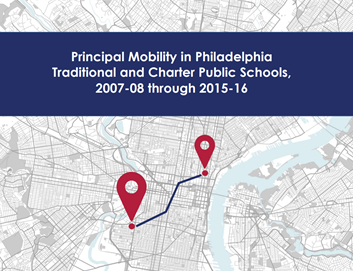By: Matthew P. Steinberg, Haisheng Yang
January 2019
Summary
Effective principals improve student achievement, develop and retain teacher talent, and manage the organization and mission of schools. Since principals become more effective over time, attracting and retaining excellent principals is a high priority for all school districts. But public school districts in large cities like Philadelphia are especially challenged to provide every school with an effective school leader. Principal mobility—that is, transferring from one school to another or leaving the principalship entirely—is disproportionately concentrated in school districts serving more low-income students and has negative consequences for student performance. For these reasons, it is critical for policymakers and school leaders in Philadelphia to have a clear picture of the extent and nature of principal mobility.
This report provides evidence on principal mobility among traditional public schools (in the School District of Philadelphia and charter public schools located in Philadelphia during the 2007-08 through 2015-16 school years. For this report, principal mobility is defined as occurring when a traditional or charter school principal does not return to the same school the following year. By this definition, a mobile principal is one who moved to another school in Philadelphia (either a traditional or charter school), moved to a Pennsylvania public school outside of Philadelphia, exited the principalship (that is, was employed in another role in education), or left public education in Pennsylvania.
The study uses data on all principals in traditional and charter schools provided by the Pennsylvania Department of Education. We describe the characteristics of principals in Philadelphia, the extent of principal mobility, and the characteristics of mobile principals and the schools that they exit.
Key Findings
-
Principals in traditional public schools in Philadelphia are, on average, older, have more education experience, are more likely to be a racial minority, and earn higher salaries than charter school principals.
-
Experience in Pennsylvania public education among traditional and charter school principals has, on average, declined over time. From 2007-08 to 2015-16, average education experience of traditional public school principals declined from 22 years to 18 years. For charter school principals, experience declined from 18 years to 14 years.
-
Principal mobility is greater in the city’s charter schools than in its traditional public schools. Across the study period, the principal mobility rate was 24 percent in traditional public schools, compared to 35 percent in charter schools.
-
Principal mobility is greater among traditional public schools in Philadelphia than the Pennsylvania statewide average but comparable to other urban Pennsylvania districts. Statewide in Pennsylvania, the principal mobility rate in traditional public schools was 19 percent during the study period; in contrast, the principal mobility rate in Pittsburgh and Philadelphia’s traditional public schools was identical (24 percent).
-
Mobile principals in Philadelphia are most likely either to remain in the same sector in Philadelphia or to exit Pennsylvania public education. Among all mobile principals in Philadelphia traditional and charter schools, 27 percent remained in the same sector while 45 percent exited public education in Pennsylvania. An additional 22 percent of mobile principals exited the principalship while remaining in public education in Pennsylvania.
-
Mobile principals in Philadelphia are concentrated in schools that serve higher-poverty, lower-achieving and minority students.
-
There are fewer novice principals in traditional public schools than charter schools. Novice principals are in their first year as a principal in Pennsylvania public schools – traditional or charter – during or after the 2008-09 school year. Over the study period, 12 percent of TPS principals and 31 percent of charter principals were novice.
-
Novice principals in traditional public schools have become younger, less racially diverse, and less experienced over time. In contrast, there is little variation over time in the experience and racial composition of novice principals in charter schools.
Policy and Implications
-
The disproportionately high rate of principal mobility among Philadelphia schools serving the most economically and academically disadvantaged students is an area for ongoing attention. Despite principal mobility rates that are similar to statewide averages and to other urban districts in Pennsylvania, principals at schools with the lowest achieving and most disadvantaged students are more mobile than their peers at schools with higher achieving and more advantaged students. These findings suggest that city and state leaders should identify ways to provide additional supports and resources to principals—particularly novice principals—who are working in schools that serve the most disadvantaged students in Philadelphia.
-
The higher rates of principal mobility and the concentration of novice principals in Philadelphia’s charter sector should inform policy choices among district and charter school leaders on the identification and retention of school leaders across sectors. Since principal mobility is related to adverse student outcomes, and principal effectiveness improves with school leadership experience, there are concerns about how these patterns may shape the schooling climate in Philadelphia charter schools. Evidence on the extent of principal mobility and the high rate of novice principals in Philadelphia charter schools should compel school leaders to identify ways to attract and retain principals in charter schools in an effort to improve the schooling outcomes of charter students.
-
Relatively few principals exited Philadelphia for other public school districts in Pennsylvania—a fact that can inform district and charter policy choices related to principal recruitment and retention. For any education agency, formulating a strategy to recruit and retain principals requires a clear understanding of the problem and a set of targeted responses. This report shows that principal departure to Pennsylvania public schools outside of Philadelphia was not a major part of the challenges that traditional public schools and charter schools face around principal recruitment and retention.

